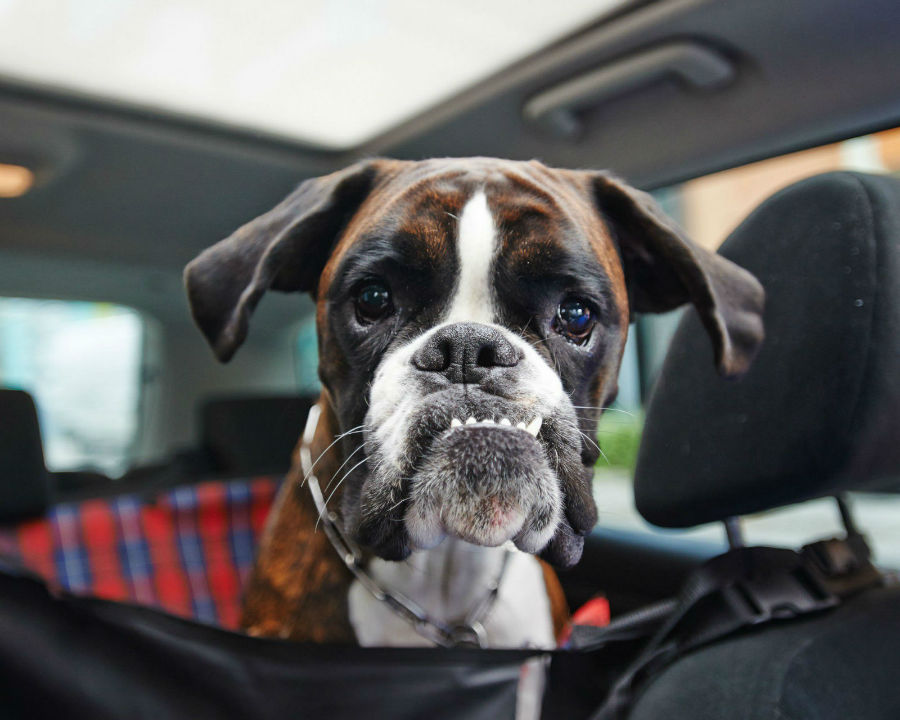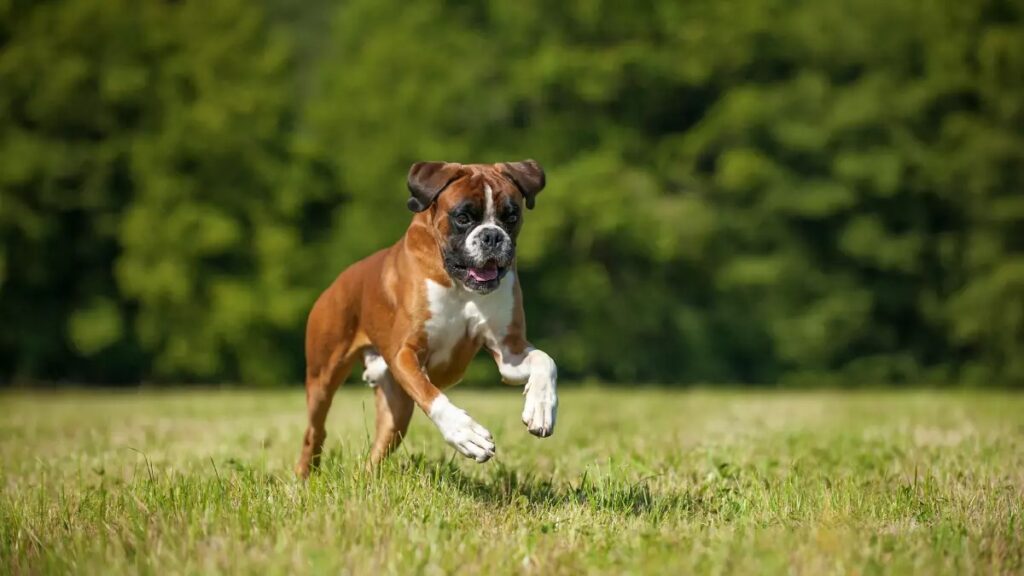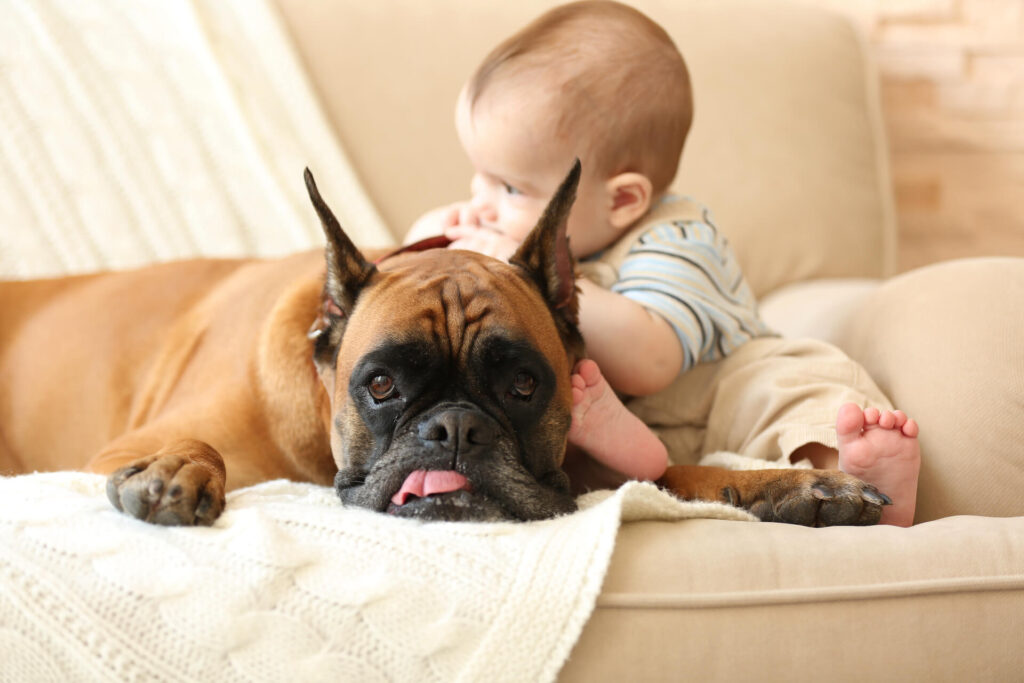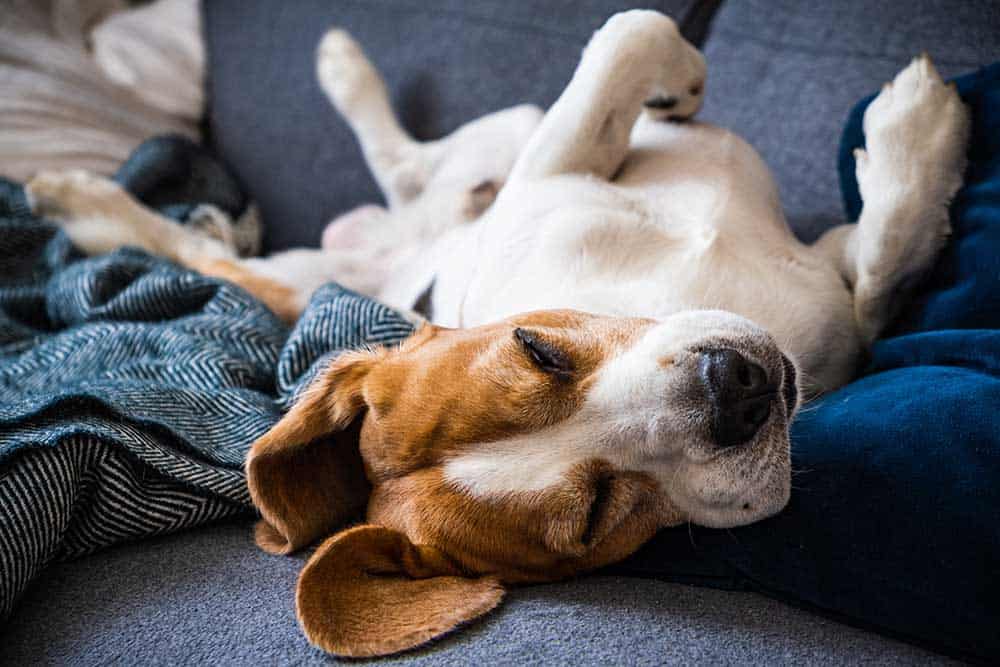How to train a Boxer
Welcome to our comprehensive guide on Boxer training. Whether you are a proud new Boxer owner or looking to enhance your training skills, this article will provide you with valuable insights and practical tips to train your Boxer dog effectively. Boxers are known for their intelligence, loyalty, and energetic nature, making them highly trainable companions.
Training your Boxer not only ensures their safety but also enhances their overall well-being and strengthens the bond between you and your furry friend. In this section, we will provide an overview of Boxer training and introduce you to effective techniques that will help you shape your Boxer into a well-behaved and obedient companion.
Principais vantagens:
- Boxers are intelligent and energetic dogs, making them highly trainable.
- Training your Boxer enhances their safety, well-being, and strengthens your bond.
- This guide will provide effective techniques and tips for successful Boxer training.
- Stay consistent, patient, and use positive reinforcement throughout the training process.
- Begin with basic commands, gradually progressing to advanced training techniques.
Understanding the Boxer Breed
Before embarking on the training journey, it is essential to have a deep understanding of the Boxer breed. Boxers are known for their energetic and playful nature, making them a popular choice for many dog lovers. These dogs are intelligent, loyal, and social creatures, known for their affectionate and friendly temperament. However, they can also exhibit strong-willed and stubborn behaviors at times.
To effectively train your Boxer, it’s crucial to tailor your approach based on their specific traits and tendencies. By understanding the Boxer breed, you can navigate through the training process more efficiently, ensuring a successful and fulfilling experience for both you and your four-legged companion.
Traits of a Boxer
Boxers possess several distinguishing characteristics that set them apart from other breeds:
- High Energy: Boxers have abundant energy levels, which require regular physical exercise and mental stimulation. Their vitality makes them an excellent choice for active individuals or families.
- Playfulness: Boxers have a natural inclination towards playfulness and love engaging in interactive activities with their human counterparts.
- Intelligence: Boxers are intelligent dogs and are quick learners. They can easily pick up new commands and tricks, making them trainable and versatile companions.
- Protective Nature: Boxers are inherently protective of their families and make excellent guard dogs. They are alert and will not hesitate to defend their loved ones if they sense danger.
- Social and Friendly: Boxers are naturally sociable dogs and thrive in the company of their human family members. They often enjoy participation in various social activities, such as playdates or dog park visits.
Training Approach for Boxers
Due to their intelligence and eagerness to please, Boxers respond well to positive reinforcement training methods. This approach involves rewarding desired behaviors with treats, praise, and play, while avoiding harsh punishments or negative reinforcement. Consistency, patience, and clear communication are the keys to successful Boxer training.
When training your Boxer, it is important to establish yourself as the pack leader and provide them with clear guidelines and boundaries. Offering mental and physical stimulation through games, obedience exercises, and interactive toys will help prevent boredom and curb any destructive behaviors derived from excessive energy.
Additionally, socialization plays a crucial role in the development of a well-rounded Boxer. Exposing your dog to various environments, people, and animals at an early age will help them become more comfortable and confident in different situations.
To summarize, by understanding the unique traits and tendencies of the Boxer breed, you can tailor your training approach to maximize success. Positive reinforcement, consistency, and socialization will be the building blocks for a well-behaved and obedient Boxer companion.
| Traits of a Boxer | Training Approach for Boxers |
|---|---|
| High Energy | Reforço positivo |
| Brincadeira | Consistência |
| Inteligência | Clear Communication |
| Protective Nature | Pack Leadership |
| Social and Friendly | Socialização |
Setting Training Goals
Establishing clear training goals is crucial for a successful training journey with your Boxer. By setting achievable objectives, you can track your progress and ensure that your training sessions are effective and productive.
When setting training goals for your Boxer, it’s important to consider their age, personality, and current skill level. Whether you are starting with basic obedience training or working towards more advanced commands and tasks, here are some tips to help you set goals that will lead to a well-trained and obedient Boxer:
- Start with the basics: Begin by focusing on foundational commands such as sit, stay, come, and heel. These commands form the building blocks of your Boxer’s training and provide a solid foundation for more complex behaviors.
- Be specific: Clearly define what you want your Boxer to accomplish. For example, instead of aiming for a general “better behavior,” set specific goals like walking nicely on a leash without pulling or responding consistently to commands, even in distracting environments.
- Break it down: Break down complex tasks into smaller, manageable steps. This helps prevent your Boxer from getting overwhelmed and allows for more focused training. For example, if you’re working on teaching your Boxer to stay, start with short durations and gradually increase the time.
- Set a timeline: Establish a realistic timeline for achieving each goal. Be patient and understand that training progress can vary from one Boxer to another. Setting a timeline helps keep you accountable and motivates you to stay consistent with your training efforts.
- Use positive reinforcement: Incorporate positive reinforcement techniques such as treats, praise, and rewards to encourage desired behaviors. This not only makes the training process more enjoyable for your Boxer but also strengthens the bond between you and your furry companion.
- Track progress: Keep a record of your Boxer’s progress to track their achievements and identify areas that need more attention. This can be done through a training journal, where you can note their successes, challenges, and any adjustments made to training techniques.
- Stay adaptable: Be flexible and willing to adapt your training goals based on your Boxer’s individual needs and progress. Not all dogs learn at the same pace, so be prepared to modify your approach as necessary.
Remember, training is an ongoing process that requires consistency, patience, and dedication. Celebrate your Boxer’s successes, no matter how small, and keep progressing towards your training goals. With the right techniques and a positive mindset, you can achieve remarkable results in training your beloved Boxer.
Sample Training Goals
| Training Goal | Descrição |
|---|---|
| Sit on command | To teach your Boxer to sit promptly when given the command. |
| Walk nicely on a leash | To prevent pulling and encourage walking calmly beside you. |
| Stay in place | To help your Boxer stay in a designated spot until released. |
| Come when called | To have your Boxer come to you reliably, even in distracting situations. |
| Deixar | To teach your Boxer to ignore and not touch certain objects or items. |
Basic Commands for Boxers
Training your Boxer to follow basic commands is essential for building a strong foundation in their obedience training. By teaching commands such as sit, stay, and come, you establish clear communication with your furry friend and promote good behavior. In this section, we’ll explore effective techniques to train these essential commands.
1. Sit Command
The sit command is one of the fundamental commands that every Boxer should learn. It teaches them to remain calm and focused in various situations. Here’s a step-by-step guide to training your Boxer to sit:
- Start by holding a treat close to your Boxer’s nose and raise it slightly above their head.
- As your Boxer follows the treat with their eyes, their bottom will naturally lower into a seated position.
- Once they are in a sitting position, say the word “sit” and immediately reward them with the treat.
- Repeat this process several times, gradually phasing out the treat until your Boxer responds to the verbal command alone.
2. Stay Command
The stay command is vital for keeping your Boxer safe in various situations, such as crossing the road or welcoming guests into your home. Here’s how to train your Boxer to stay:
- Start with your Boxer in a sitting position.
- Hold your hand up, palm facing outward, and say the word “stay” in a firm and commanding tone.
- Take a step back and wait for a few seconds. If your Boxer maintains their position, reward them with praise and a treat.
- Gradually increase the distance and duration of the stay command over multiple training sessions.
3. Come Command
The come command is crucial for calling your Boxer back to you, ensuring they stay safe and close by in different environments. Here’s how to train your Boxer to come when called:
- Find a quiet and secure space, such as your backyard, to practice the come command.
- Get down to your Boxer’s level, call their name, and say the word “come” in an enthusiastic tone.
- As your Boxer starts moving toward you, offer plenty of praise and reward them with a treat when they reach you.
- Gradually increase the distance between you and your Boxer, practicing the come command in various settings.
Remember, consistency and positive reinforcement are key to successful training. Keep training sessions short, frequent, and enjoyable for your Boxer, and always reward their good behavior. With patience and practice, your Boxer will soon master these basic commands, setting the stage for more advanced training in the future.
“Basic Obedience Commands for Your Dog.” American Kennel Club, www.akc.org.
“How to Teach a Dog to Stay.” The Humane Society of the United States, www.humanesociety.org.
“Teaching Your Dog to Come When Called.” ASPCA, www.aspca.org.
Positive Reinforcement Training
Positive reinforcement is a highly effective and humane training method for Boxers. By using rewards and praise, you can motivate your Boxer and reinforce positive behaviors. This section will guide you through the principles and techniques of positive reinforcement training, enabling you to establish a strong bond with your furry companion.
When training your Boxer, it’s important to focus on rewarding good behavior rather than punishing mistakes. Positive reinforcement involves providing incentives, such as treats or verbal praise, to encourage your Boxer to repeat desired actions. This approach not only builds trust and strengthens the bond between you and your dog but also makes the training process more enjoyable for both of you.
One of the key benefits of positive reinforcement training is that it helps your Boxer understand what you expect from them. By associating rewards with specific actions, your dog learns to make positive associations and willingly follows your commands. This method is especially effective for Boxers, who are known for their eagerness to please their owners.
When implementing positive reinforcement techniques, timing is crucial. The reward should be given immediately after your Boxer performs the desired behavior, so they can make a clear connection between the action and the reward. Be consistent in your praise and rewards to reinforce good behavior consistently.
Techniques for Positive Reinforcement Training
Here are some effective techniques you can use during positive reinforcement training:
- Clicker Training: Use a clicker to mark the desired behavior and follow it up with a treat or praise. This helps your Boxer understand when they have done something correctly.
- Food Rewards: Use small, bite-sized treats that your Boxer loves as rewards for good behavior. Make sure the treats are easily consumable and do not interfere with the training flow.
- Verbal Praise: Pair spoken cues, such as “good boy” or “good girl,” with rewards to reinforce positive behavior. Your Boxer will associate these words with a job well done.
- Playtime and Affection: In addition to treats and praise, don’t forget to shower your Boxer with playtime and affection as rewards. This helps strengthen the bond between you and reinforces positive associations with training.
Remember, consistency and patience are essential when using positive reinforcement training. Each Boxer learns at their own pace, so it’s important to be patient and persistent. With time and practice, your Boxer will become a well-behaved and obedient companion.
Crate Training for Boxers
Crate training is a valuable tool for Boxer training, serving multiple purposes such as housebreaking and providing a secure and comfortable space for your furry companion. Introducing your Boxer to crate training can greatly facilitate their obedience training and overall behavior.
When beginning crate training, it’s essential to create a positive and comfortable association with the crate. Place the crate in a quiet area of your home, away from excessive noise or distractions. Line it with soft bedding and leave the door open to encourage your Boxer to explore it freely.
Initially, entice your Boxer into the crate by placing treats or a favorite toy inside. Let them enter the crate voluntarily and reward them with praise and treats. Repeat this process several times, gradually increasing the amount of time they spend inside the crate.
It’s important to never force your Boxer into the crate or use it as a form of punishment. The crate should always be seen as a safe and positive space, not a place for confinement or isolation.
A crate helps with housebreaking because dogs naturally avoid soiling their sleeping areas. When your Boxer is in the crate, they will be less likely to have accidents inside the house. However, it’s crucial to take your Boxer outside to eliminate before placing them in the crate and immediately after letting them out.
Gradually extend the duration of time your Boxer spends in the crate, starting with short intervals and gradually building up to longer periods. Avoid leaving your Boxer in the crate for extended periods, as this can lead to anxiety and distress.
Remember: Crate training should always be done with patience and consistency. Each Boxer is unique, and the time it takes for them to acclimate to the crate may vary. Be understanding and provide plenty of positive reinforcement throughout the process.
By following these crate training tips, you can create a positive and stress-free crate experience for your Boxer, enabling them to view it as their safe haven and aiding in their overall training and behavior.
Continue reading to section 7 to learn about leash training and walking etiquette for Boxers.
Key points:
- Introduce the crate as a positive and comfortable space
- Use treats and praise to encourage your Boxer’s exploration of the crate
- Gradually increase the time spent in the crate
- Never force your Boxer into the crate or use it for punishment
- Use the crate to aid in housebreaking
- Be patient and consistent throughout the crate training process
Leash Training and Walking Etiquette
Teaching your Boxer to walk on a leash properly is essential for their safety and your enjoyment. Leash training not only allows you to control your Boxer’s movements but also helps them learn proper walking etiquette. Follow these tips to ensure a pleasant and controlled walking experience for both you and your furry friend.
When starting leash training, it’s important to choose an appropriate leash length and type. A sturdy leash, preferably made of nylon or leather, with a length of about 4-6 feet is ideal for most walking situations. Avoid retractable leashes, as they can give your Boxer too much freedom and make it difficult to maintain control.
Before beginning your walk, it’s essential to ensure that your Boxer is calm and focused. Practice basic obedience commands such as sitting and staying before attaching the leash. This will help create a positive and controlled mindset for your Boxer.
During the walk, maintain firm control of the leash without pulling or yanking. Use gentle and consistent guidance to direct your Boxer’s movements. Avoid excessive tension on the leash, as it can cause discomfort and lead to a negative walking experience.
As you walk, encourage your Boxer to stay by your side. A loose leash is a sign of a well-trained dog. If your Boxer starts pulling, stop walking and wait for them to calm down. Resume walking only when they return to your side and the leash is loose. Reward your Boxer with praise, treats, or a favorite toy for walking nicely on a loose leash.
It’s important to be aware of your surroundings and practice good walking etiquette. Keep your Boxer on the designated walking path, and always clean up after them if they relieve themselves. Be respectful of other pedestrians, and teach your Boxer to walk politely past people and other dogs without jumping or excessive barking.
Gradually increase the duration and complexity of your walks as your Boxer becomes more comfortable with leash training. Introduce different terrains and walking environments to expose them to a variety of sights, sounds, and smells. This will help build their confidence and improve their overall walking behavior.
Remember, leash training requires patience, consistency, and positive reinforcement. Celebrate your Boxer’s successes and provide gentle guidance for areas that need improvement. With time and practice, your Boxer will become a well-behaved and enjoyable walking companion.
Advanced Training Techniques
Once your Boxer has mastered the basic commands, it’s time to take their training to the next level. Advanced training techniques can help enhance your Boxer’s skills and provide mental stimulation. In this section, we will explore some effective methods to further develop your Boxer’s obedience and agility.
Treinamento de agilidade
Agility training is not only a fun activity but also a great way to improve your Boxer’s physical fitness and coordination. By setting up obstacle courses, such as tunnels, jumps, and weave poles, you can challenge your Boxer’s agility and problem-solving abilities. Start with simple obstacles and gradually increase the difficulty level as your Boxer becomes more adept.
“Agility training is a fantastic way to bond with your Boxer while keeping them mentally and physically engaged.”
Advanced Commands
Building on the basic commands, you can teach your Boxer more advanced commands to expand their training repertoire. These commands can include tricks like roll over, play dead, or give paw, which not only impress others but also boost your Boxer’s cognitive abilities. Take it slow and use positive reinforcement to make the learning process enjoyable for your Boxer.
Treinamento Avançado de Obediência
Obedience training goes beyond teaching basic commands. It focuses on refining your Boxer’s behavior and response in various situations. Advanced obedience training includes off-leash recall, heelwork, and stay for extended durations. Consistency and patience are crucial during this phase of training, as it requires more focus and self-control from your Boxer.
Target Training
Target training involves teaching your Boxer to touch a specific object, such as a target stick or your hand, with their nose or paw. This technique is useful for developing focus and precision. Once your Boxer becomes proficient, you can use target training to teach them complex tricks or behaviors, like turning off lights or closing doors.
| Técnica de Treinamento | Descrição |
|---|---|
| Treinamento de agilidade | Set up obstacle courses to improve your Boxer’s physical fitness and coordination. |
| Advanced Commands | Teach your Boxer impressive tricks to expand their training repertoire. |
| Treinamento Avançado de Obediência | Refine your Boxer’s behavior and response in various situations. |
| Target Training | Teach your Boxer to touch a specific target object to develop focus and precision. |
Remember to practice these advanced techniques in a controlled and safe environment. Be patient with your Boxer as they learn new skills, and always reward their progress with praise and treats. With consistent training and positive reinforcement, your Boxer will continue to grow and excel in their abilities.
Socializing Your Boxer
Socialization plays a crucial role in developing a well-rounded and confident Boxer. By exposing your Boxer to various environments, people, and animals, you can help them become comfortable and adaptable in different situations.
When it comes to socializing your Boxer, early and consistent exposure is key. Start by introducing them to different sounds, sights, and smells from a young age. This will help them become familiar with their surroundings and reduce the likelihood of fear or anxiety in new environments.
One important aspect of socializing your Boxer is introducing them to other dogs. Arrange playdates with well-behaved and vaccinated dogs to ensure a positive and safe interaction. Monitor their interactions closely and intervene if necessary to prevent any aggressive behavior.
In addition to other dogs, it’s essential to expose your Boxer to different people, including adults, children, and individuals wearing hats or uniforms. This will help them become comfortable around different types of people they may encounter in various settings.
When socializing your Boxer, it’s crucial to prioritize their safety. Always ensure that interactions are positive and controlled. If your Boxer shows signs of fear or discomfort, take a step back and provide them with reassurance.
“Socialization is a vital part of Boxer training and development. By exposing your Boxer to various environments, people, and animals, you are helping them build confidence, reduce fear, and become well-adjusted companions.” – Dr. Sarah Adams, Canine Behavior Specialist
Remember, socializing your Boxer is an ongoing process. Continue to provide opportunities for positive experiences throughout their life. Consider enrolling them in puppy classes or obedience training where they can learn to interact with other dogs under professional supervision.
By prioritizing socialization, you are setting your Boxer up for success in various social situations. A well-socialized Boxer is more likely to be calm, confident, and obedient, making them a joy to have in any setting.
Troubleshooting Common Behavioral Issues
Training a Boxer can sometimes come with challenges as they may display certain behavioral issues. In this section, we will address some common problems such as biting, jumping, and separation anxiety, and provide effective techniques to tackle them.
1. Biting
Biting is a common issue among Boxer puppies who are teething or haven’t learned bite inhibition. To prevent biting, redirect their attention to appropriate chew toys whenever they begin to nip at hands or furniture. Consistency is key – reward them for chewing on toys and firmly say “no” when they bite inappropriately.
2. Jumping
Boxers tend to be enthusiastic and may display jumping behavior when excited. To address this, teach your Boxer the “off” command by gently pushing them off and rewarding them for keeping all four paws on the ground. Consistently reinforcing this command and discouraging jumping will help curb this behavior.
3. Separation Anxiety
Boxers are known for their loving and loyal nature, which can sometimes result in separation anxiety when left alone. To alleviate this, gradually desensitize your Boxer to being alone by starting with short periods and gradually increasing the duration. Provide them with interactive toys or comforting items to help keep them occupied in your absence.
| Behavioral Issue | Techniques to Address |
|---|---|
| Biting | Redirect to appropriate chew toys, reward for chewing on toys, say “no” when biting inappropriately |
| Jumping | Teach the “off” command, reward for four paws on the ground, consistently discourage jumping |
| Ansiedade de separação | Gradually desensitize to being alone, provide interactive toys or comforting items |
By implementing these techniques and remaining consistent in your training approach, you can overcome common behavioral issues and create a harmonious relationship with your Boxer.
Consistency and Patience in Training
Consistency and patience are crucial elements when it comes to training your Boxer. Both of these qualities will contribute to a successful and effective training routine. By reinforcing consistent behavior and patiently guiding your Boxer, you can establish a strong bond and create a well-trained and obedient companion.
Consistency means following a set schedule and using the same commands, gestures, and rewards consistently throughout the training process. This helps your Boxer understand what is expected of them and reduces confusion. Whether it’s practicing commands, walking on a leash, or crate training, sticking to a consistent approach will lead to better results.
Patience is equally important as some Boxers may take longer to grasp certain concepts or behaviors. It’s essential to remain calm and patient, allowing your Boxer the time they need to learn and understand. Rushing or becoming frustrated can hinder progress and frustrate your furry friend. Remember, each dog is unique and will respond to training at their own pace.
Consistency and Patience Tips:
- Establish a consistent training routine and allocate dedicated time for training sessions every day.
- Use the same cues and hand signals for commands consistently.
- Reward your Boxer immediately when they exhibit the desired behavior.
- Be patient during the training process and avoid getting frustrated or angry.
- Set realistic expectations and understand that progress may take time.
- Practice positive reinforcement and praise your Boxer for their efforts.
- Stay consistent with rules and boundaries to maintain a structured environment.
- Keep training sessions short and engaging to prevent boredom or fatigue.
By incorporating consistency and patience into your Boxer’s training regimen, you are setting them up for success. Remember, training is an ongoing process, and it requires dedication and commitment. With time and the right approach, your Boxer will become a well-behaved and obedient member of your family.
Conclusão
Through this comprehensive guide, you have learned valuable insights into Boxer training. By implementing the right techniques and tips, you can successfully train your Boxer and nurture a strong bond with them.
Consistency and patience are vital when it comes to training Boxers. Remember to set clear goals and use positive reinforcement to encourage desired behaviors. Whether it’s teaching basic commands, crate training, or advanced techniques, a firm yet gentle approach will yield the best results.
Socializing your Boxer is equally important for their overall development. Exposing them to various environments, people, and animals will help them become well-rounded companions. Additionally, troubleshooting common behavioral issues and addressing them promptly will pave the way for a harmonious relationship.
By embracing the principles of Boxer training, you can transform your beloved canine into a well-trained and obedient companion. Remember, training requires dedication, consistency, and a positive mindset. With these qualities, you have the power to unlock your Boxer’s full potential and create a fulfilling and enriching experience for both of you.
Perguntas frequentes
How can I train my Boxer dog?
Training your Boxer dog requires patience, consistency, and positive reinforcement. Start by teaching basic commands like sit, stay, and come. Use rewards and praise to motivate and reinforce good behavior. Gradually progress to advanced training techniques and ensure you socialize your Boxer to develop a well-rounded companion.
What are the characteristics and behavior of Boxer dogs?
Boxer dogs are known for their high energy level, intelligence, and playful nature. They are loyal and protective, making them great family pets. However, they can be stubborn at times, so it’s important to establish yourself as the leader and use positive reinforcement techniques in their training.
How do I set training goals for my Boxer?
Setting training goals for your Boxer is essential for a successful training journey. Start by identifying specific behaviors or commands you want to teach your dog. Break these goals down into smaller, achievable steps. Track your progress and adapt your training approach as needed.
What are some basic commands I should teach my Boxer?
Teaching basic commands is crucial for Boxer training. Some important commands to start with include sit, stay, come, and down. These commands lay the foundation for further training and help establish boundaries and discipline.
How does positive reinforcement training work?
Positive reinforcement training involves rewarding your Boxer for good behavior. This can be done through treats, praise, or playtime. By associating positive experiences with desired behaviors, your Boxer will be motivated to repeat those behaviors. Avoid punishment or harsh training methods, as they can damage the bond between you and your dog.
How do I crate train my Boxer?
Crate training is a useful tool for housebreaking and providing a safe space for your Boxer. Introduce the crate gradually, using positive reinforcement to make it a positive and comfortable place for your dog. Start with short periods of time and gradually increase the duration. Never use the crate as a form of punishment.
How can I leash train my Boxer?
Leash training is important for the safety and control of your Boxer. Start by introducing your dog to the leash and collar in a positive and calm environment. Use treats and praise to reward your dog for walking calmly by your side. Be consistent and patient, gradually increasing the length and complexity of your walks.
What are some advanced training techniques for Boxers?
Once your Boxer has mastered the basic commands, you can progress to advanced training techniques. Consider agility training, which can help improve your Boxer’s physical and mental abilities. You can also teach complex commands, tricks, and engage in interactive games that challenge their intelligence and problem-solving skills.
Why is socialization important for my Boxer?
Socialization is crucial for developing a well-rounded and emotionally stable Boxer. Exposing your dog to different environments, people, and animals from an early age helps prevent fear, aggression, and anxiety. Take your Boxer to dog parks, arrange playdates, and enroll them in obedience classes to enhance their social skills.
How can I address common behavioral issues in my Boxer?
Boxers may experience behavioral issues such as biting, jumping, or separation anxiety. Consistent training, redirection, and positive reinforcement can help address these issues. Seek professional help if needed and be patient, as it may take time to modify unwanted behaviors.
Why is consistency and patience important in Boxer training?
Consistency and patience are key to successful Boxer training. It’s necessary to establish consistent routines, commands, and rewards to avoid confusion. Patience is required as every dog learns at a different pace. Stay patient during the training process and celebrate even small achievements to keep your Boxer motivated.






